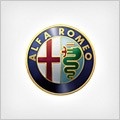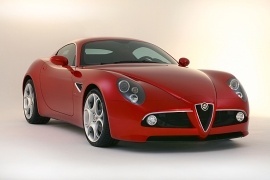
ALFA ROMEO 8C
Generations Timeline, Specs and Pictures

From 1931 to 1934, Alfa Romeo won the Le Mans 24-hour race four times in a row, with the original 8C model.
The 2008 Alfa Romeo 8C remake was a sensational car that was more powerful than most other cars in its segment, like the Audi R8 or the Aston Martin Vantage. The 2-seater supercar’s body was almost entirely made of carbon fiber, thus having a reduced weight. The striking body had a long nose and a short tail, looking pretty much like a modern Ferrari Daytona.
The chassis was borrowed from the Maserati Grand Sport, as well as the powerful 4.7-liter V8 engine. The engine produced 450 hp and is paired with a 6-speed automatic transmission. The car could rocket from 0 to 60 mph in around 4.2 seconds. Only 500 Alfa Romeo 8C Spider were produced, the majority of them being delivered to Europe and a few to the UK. It is said that the car’s top speed was 182 mph.
With the powerful engine came even more powerful brakes, the car being equipped with huge vented Brembo discs behind the 20-inch alloys. The car’s interior was equipped with a beautiful luxurious leather, it had no rear seats and the luggage compartment was almost nonexistent. That being sad, this car was not created to be a family vehicle.

The right car at the right moment was not the case for the Alfa Romeo 8C Competizione, which was introduced at the 2006 Paris Motor Show.
When the car was launched, the car-maker received over 1400 orders for it but, in 2007, when the dark clouds of the world economy crisis gathered, that list was shrunk, and since Alfa Romeo said that it will build only 500 of it. And that what it did.
Its long hood, triangular headlights with three headlamps inside, the Alfa Romeo shield in the middle of the grille extended with a bulge over the hood were some of the distinctive design cues of the car. The cabin was pushed further back and there was virtually no rear deck. For the taillights, the Alfa Romeo designers chose the round types, like the older Alfa Romeo sports cars.
Inside, the 8C Competizione featured two sport-bucket seats taken from Ferrari. They were built from carbon-fiber and covered with leather. The high center console hosted the buttons for the gearbox functions and driving modes, parking-brake switch, and the start-button. The instrument cluster featured two big dials and an LCD between them. In the back, there was a shelf for luggage. The trunk was almost non-existent.
The 8C was powered by a modified engine taken from the Maserati. It was mated to a 7-speed, dual-clutch gearbox mounted in the back. The limited-slip differential was standard as well. The top speed was slightly slower than the one of a Ferrari. Just because when you are Alfa Romeo, you don’t want to irritate your bigger brother.

The Alfa Romeo 8C 2900B was introduced in 1936, as a result of company’s desire to develop a second version of the 8c 2900 race car.
Although it was designed to compete in Sports Car competitions, the 8C 2900B was also available for road use. Only 20 units were available for public roads due to high production prices. Its rivals on the sports car sector were the Bugatti 57S Atlantic, Mercedes 540K Spezial Roadster and Duesenberg SJ. The model was available with a choice of two wheelbases - 2800mm and 3000mm - and was equipped with a 2.9L engine delivering no less than 182 hp.

Alfa Romeo was already a race-winner in 1931 when it introduced the 8C Roadster as a sports-car for the public, and the new car promised to be a trophy-winner, and it was.
Alfa Romeo built just 188 cars for the market while the rest were race-cars. In those times, the differences between a race car and its showroom cousin were minimal. Tazio Nuvolari won the 1931 Italian Grand Prix at Monza race-track and the 1931-1932 Targa Florio road-race.
The 8C featured a unique front fascia for those times, sporting a three-headlamps at the front, in front of the radiator’s grille. That’s why the carmaker had to move the “Alfa Romeo” lettering on the lower side. There was no bumper for the race version. Yet, the street model featured a slim, easy to remove one. The two-seat cabin was just in front of the rear axle. To make the car more aerodynamic, the carmaker installed an aerodynamic shield on top of the spare-wheel. Last but not least, it featured an aluminum bodywork over a steel chassis.
Inside, the carmaker placed large dials from left to right of the dash-panel. In front of the co-driver, Alfa Romeo installed a clock and the fuel gauge. These were important, especially during a road race. In those times, the Italian carmakers installed the driving posts on the right side of the car, even if they were driving on the road’s right side. Inside the cabin, the carmaker installed a solid, metallic handle (sort of an Oh-My-God bar) on the passenger’s side.
Under the hood, Alfa Romeo installed an inline-eight engine with dual overhead camshafts and two valves per cylinder. A roots-type supercharger fed it through a Memini double-barrel carburetor.























































